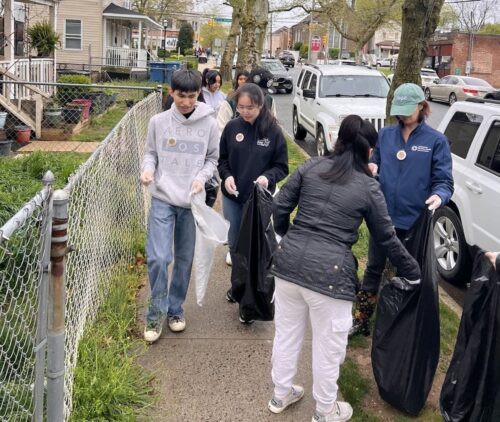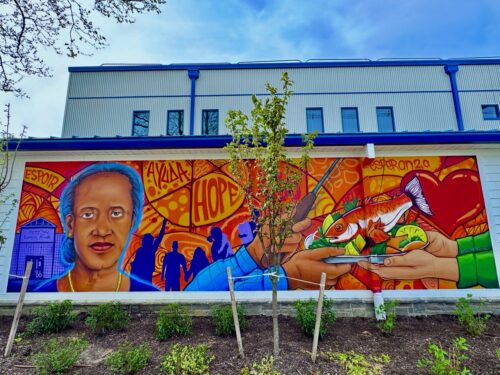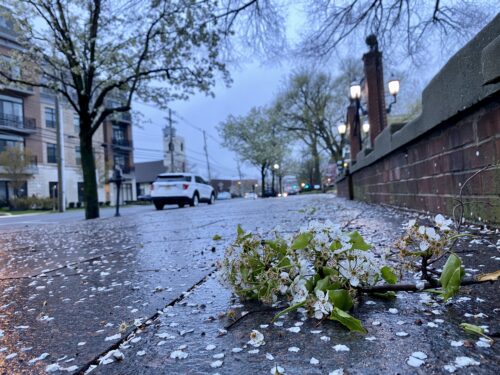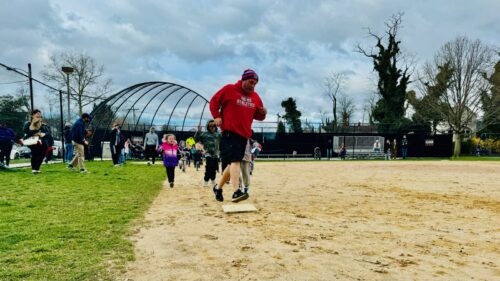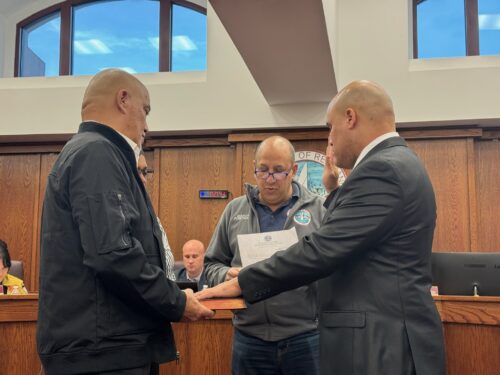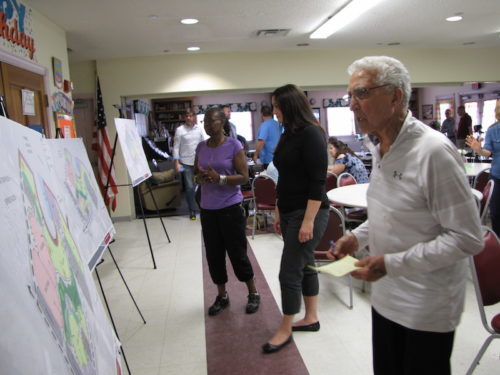 Restaurateur Danny Murphy was among the Red Bank residents checking out the newly unveiled concept design plans for Marine Park Wednesday afternoon at the Senior Center.
Restaurateur Danny Murphy was among the Red Bank residents checking out the newly unveiled concept design plans for Marine Park Wednesday afternoon at the Senior Center.
What do the plans show? Click ‘Read More’ to find out. (Photo by John T. Ward. Click to enlarge.)


 The three concept plans on which the audience at two input sessions voted Wednesday. (Photo by John T. Ward. Click to enlarge.)
The three concept plans on which the audience at two input sessions voted Wednesday. (Photo by John T. Ward. Click to enlarge.)
By JOHN T. WARD
An urban planning firm hired by Red Bank unveiled three concept plans for a remodeled Marine Park Wednesday, inviting residents and visitors to weigh in on their favorite features.
The debut at the second round of a continuing public-input process begun last month, enabled attendees to express their preferences for possible features in the park, which sits on the Navesink River in the oldest part of town.
About two dozen residents, including a host of elected and appointed government officials, were present at the first of two sessions held Wednesday. Using handheld wireless clickers, they answered a series of questions about likes and dislikes, and at the end indicated their favorite concept overall.
Though discussion of the clay tennis courts was the number-one topic of discussion at two sessions held April 9, only 10 percent of the Wednesday afternoon crowd identified the park’s clay tennis courts as their favorite feature of the facility. The waterfront promenade won that designation, with 39 percent of the clicks.
Other results from the afternoon session:
• Given a choice of tennis, pickleball, shuffleboard and bocce courts, 62 percent expressed a preference for ‘none’ in the park.
• Seventy percent did not want to see a skating facility in the park.
• Ninety-five percent want the park to continue to have a playground.
• Sixty-eight percent consider the addition of a kayak launch ‘valuable.’
• Seventy-four percent don’t want a dog run in the park.
• What do they value most about the park? The seasonal events, said 48 percent; another 24 percent cited the water views.
Those selections were made before landscape architect Scott Scarfone, of the urban planning firm Kimley-Horn, gave presentations on the three concept plans. Each, he said, was meant to loosely suggest the placement and size of various features, such as an entry plaza or pavilion. Concept 1, for example, would eliminate the tennis courts and replace them with a playground and skate park. The park’s sloping, amphitheater-like lawn would be turned into a natural, low-maintenance “meadow.” And it would have a prominent plaza to “announce” the park to visitors.
The second plan keeps two of the existing four tennis courts, giving the others over to a skate park. It also relocates the playground to a point higher up on the slope.
Concept 3 would move half of the park’s 82 parking spaces to the tennis court site, and for the remaining spots, create a circular parking area.
“This one makes the parking lot a lot less monumental,” Scarfone said.
Instead of a meadow, the existing slope would be terraced, with seating platforms.
All three plans maintain the existing sewage pump station and restrooms; relocate the pump’s service road to the park’s western edge; increase the green space along the promenade; and call for the addition of a floating kayak and canoe launch inside the horseshoe-shaped marina operated by the borough.
“We’d like to dress up the pump station somehow,” using screening or other concealments, Scarfone said. “It’s not moving.”
The idea of the illustrations, Scarfone said, “is to generally establish what the component pieces of the park will be.” The elements can be mixed-and-matched across concept plans, relocated and altered in size, he said.
The hearing process, said Scarfone, is aimed at “trying to give the constituencies of Red Bank as many options as possible to give input.”
That includes a questionnaire on the town’s website to solicit additional input.
What did the afternoon audience think of the concepts? Concept 1 was preferred by 41 percent, concept 2 by 27 percent, and concept 3 by 32 percent, according to the clicker tally.
Several attendees, though wondered about the costs, and whether the need for hard surfaces to accommodate festival vendors would dictate the ultimate design.
“To determine costs, we first need a detailed plan,” Scarfone responded. As for the constraints on design, right now he said, there are none, though they’re sure to come into play.
“We’re working our way down toward the end of the funnel” without any “preconceived ideas,” he said. “A lot of these things may go away, but we’re still at the top of the funnel.”
Scarfone said the input would be merged into a single proposal, to be made available at the next round of public sessions, which have not yet been scheduled.



